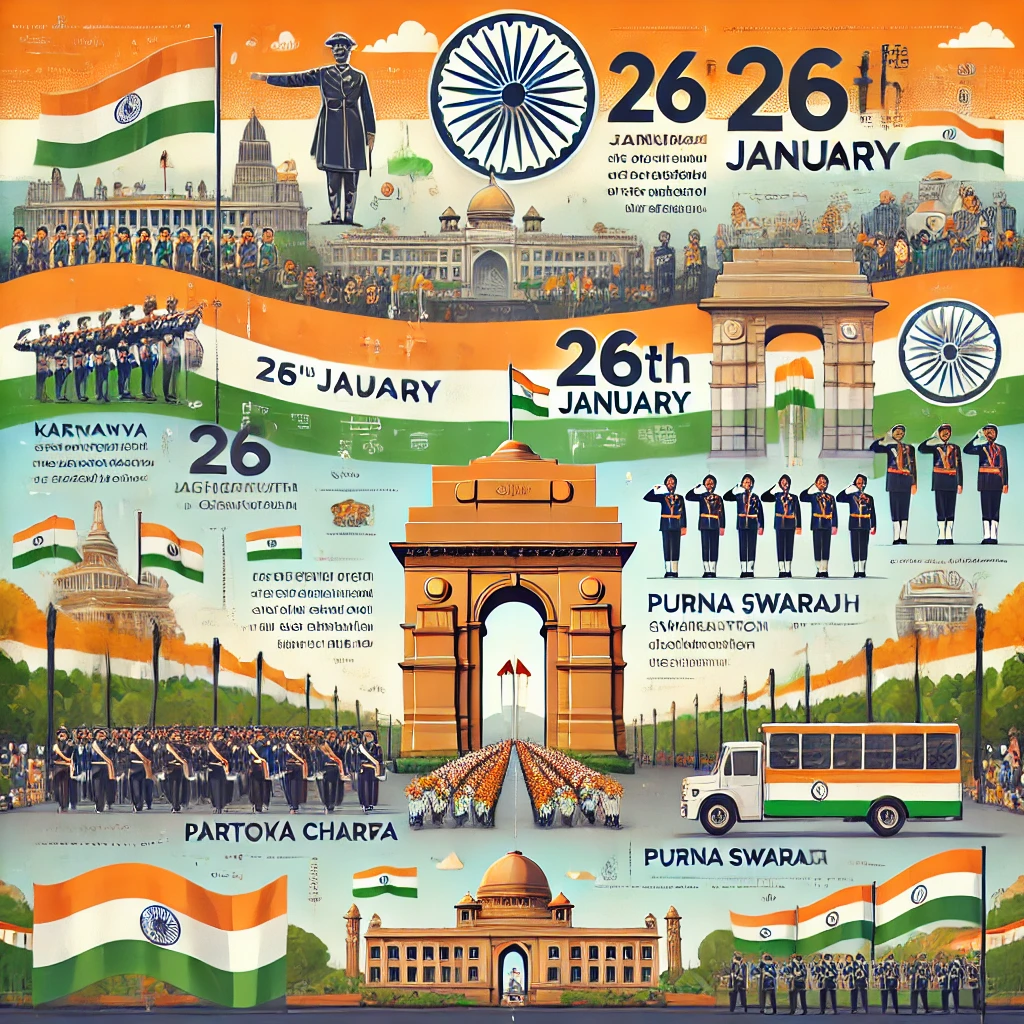
This article has been written by Anushree Jha, University of Mumbai, Thane Sub-Campus.
Abstract:-
This comprehensive research article contains a detailed analysis of ‘Republic Day’ as celebrated each year on the 26th of January. This research article seeks to explain and analyse the significance of Republic Day through a constitutional lens, aiming to delve into the framing of the Indian Constitution, the objectives resolution of 1946 and the concept of republicanism under the Indian Constitution as a salient feature. Additionally, this research endeavour shall also delve into the key role of Dr. B.R. Ambedkar as the Chairman of the drafting committee and his contribution in the crafting of the constitutional ideals.
As we all stand aware, the Indian Republic Day is observed each year on January 26 to honour the 1950 adoption of the Indian Constitution, which signalled the country’s transformation into an independent republic. It is imperative to note that understanding the key significance of this historic event must be accompanied by a deep dive into the historical background of the Indian Constitution’s creation, which has been duly covered by this research article. Through a keen study, This research endeavour seeks to provide a valuable source of knowledge for legal practitioners, law enthusiasts and students alike.
Keywords:- Indian Republic Day, Indian Constitution, Dr. B.R. Ambedkar, Constitutionalism, Republicanism
Introduction:-
A ‘Republic’, according to the Oxford Learner’s Dictionary is defined as “a country that is governed by a president and politicians elected by the people and where there is no king or queen”[1]. The date of 26th January 2025 marked 75 years since the Indian Constitution came into effect on January 26, 1950. The significance of the ‘Republic Day’ marked by the nation’s joy and the much-awaited parade of our battalions can never be overstated. The significance of Republic Day is increased after a realisation that it is the date of adoption of our Indian Constitution, the highest and most fundamental law of the land. India marked the historic day of the date of adoption of our pious constitution by marking the date as a holiday to be celebrated throughout the country, making us realise the significance of the contribution of our constitutional forefathers.
In simple words, The adoption of India’s Constitution on January 26, 1950, marked the culmination of its independence path. This historic event marks the founding of India as a sovereign, democratic, secular, socialist nation. Republic Day is not only a historical remembrance; it is also a celebration of India’s democratic spirit and a reaffirmation of the values found in the Constitution. Celebrated on January 26th every year, India’s Republic Day commemorates the country’s adoption of the Constitution, which made it a sovereign democratic republic.[2] This day is significant under the constitution and serves as a reminder of the country’s progress toward unity and self-governance.
India as a ‘Republic’:-
Constitutional Law has no steadfast definition. The Constitution of any land can be described as the basic principles and laws of a nation, state, or social group that determine the powers and duties of the government and guarantee certain rights to the people in it[3]. The Constitution, by itself, possesses the structures and processes of government and the fundamental rights of citizens in a higher law that cannot be unilaterally changed by an ordinary legislative act[4]. It is a document having a special legal sanctity which sets out the framework and the principal functions of the organs of the Government of a state and declares the principles governing the operation of those organs. Hence, the Constitution as a political document strives to construct a common, national, political and constitutional identity for the people who are subjected to it. ‘Republicanism’ is a very significant salient feature of the Indian Constitution, which is celebrated and also supported by various other important features of the constitution.
Aside from being a modern constitution which is best suited to the social, economic, political, and cultural situations of the country, The Indian Constitution has taken several significant principles, procedures and provisions of other countries and adopted it within itself and has, at the end, come out with its own ability to choose, new directions, methods, principles, and constantly aiming at new constitutional innovations. As we all know, The Indian Constitution is the lengthiest written constitution in the world. It is a comprehensive, elaborate and detailed document where there is a single constitution for both the Centre and the states. In regards to it being drawn from various sources, It has borrowed most of its provisions from the constitutions of various other countries, for example, Fundamental Rights from the USA[5], etc. Similarly, France was the source of the Indian Constitution’s notion of republicanism[6]. For India, the idea of a republic—a government in which the head of state is an elected individual rather than a monarch—was largely inspired by the French Constitution. Likewise, The Preamble of the Indian Constitution reflects the French Republic’s core values of liberty, equality, and fraternity as well.
In the spirit of being a republic, India is not ruled by a monarch or a nominated head of state. India has an elected head of state (The President of India) who wields power for a fixed term of 5 years. Additionally, The Indian Constitution has also setup various independent bodies and vested them with powers to ensure the application of constitutional provisions. These include the Election Commission and the Finance Commission. To guarantee that they are not subject to the whims of the legislative or executive branches, these institutions have been given set service conditions, tenure security, and other protections.[7]
At the same time, with the view of being a sovereign, socialist, secular, democratic republic, The Indian Constitution prescribes a democratic system of governance where free, fair and regular elections are held to elect governments and the authority of the government rests upon the sovereignty of the people. Therefore, The people enjoy equal political rights. Additionally, through the 73rd and 74th Amendment acts, we also have rural and urban local bodies as an additional constitutional tier of the government structure[8].
Framing of the Indian Constitution:-
The supreme law of India is the Constitution. It establishes the foundation for national governance, including the roles and responsibilities of the legislative, executive, and judicial branches of government. It ensures justice, liberty, equality, and fraternity by guaranteeing all citizens their fundamental rights. With the ratification of the Constitution, colonial control came to an end and self-governance was established, establishing a system founded on people sovereignty and the rule of law. It is imperative to understand the framing of the Constitution to understand its complete significance.
Before the framing of the constitution started, an Objectives Resolution (the resolution that defined the aims of the Assembly) was moved by Jawaharlal Nehru in 1946[9]. During the first session of the Constitutional Assembly, Jawaharlal Nehru proposed “The Objective Resolution, 1946.” The objective resolutions provided a much-needed philosophy to the Indian Constitution and affected its formulation. These resolutions fundamentally reflected the aspirations of the individuals who were writing the Constitution, thus establishing the concept and guiding principles for building the Constitution. These resolutions were also included in the Preamble of the Indian Constitution. Jawaharlal Nehru introduced these resolutions on December 13, 1946, and the assembly adopted these resolutions on January 22, 1947.
The Objective Resolution is detailed below[10]:-
- India is a sovereign, independent republic
- India should be a union comprising of former British Indian territory, Indian States, and additional areas outside of British India and the Indian States that choose to join the Union.
- The territories that comprise the Union shall be autonomous units, exercising all powers and responsibilities of government and administration save those designated to or vested in the Union.
- All sovereign and independent India’s powers and authority, as well as its constitution, should derive from the people.
- All Indians must be guaranteed social, economic, and political fairness; equality of position and opportunity; equality before the law; and basic freedoms – of expression, belief, faith, worship, vocation, association and action – subject to the law and public morality.
- Minorities, backward and tribal communities, the poor and other disadvantaged groups must be well protected.
- The territorial integrity of the Republic, as well as its sovereign rights on land, sea and air, should be preserved in accordance with civilized country justice and law.
- The country would contribute fully and willingly to the advancement of world peace and the well-being of humanity.
‘Republicanism’ under the Preamble:-
The Preamble in the Indian Constitution has been adopted from the constitution of the USA. Nani Palkhiwala has defined the ‘Preamble’ as the “Identity card of the constitution[11].” A preamble, in simple words, consists of the essence of the Constitution. The nature of the Indian Constitution is “Sovereign, Socialist, Secular, Democratic, Republic”. The Objectives Resolution is the source of the Indian preamble. In simple terms, the nature of the Indian Preamble can be defined as[12]:-
- Sovereign:- India is an independent country with the freedom to conduct its own internal and external affairs.
- Socialist:- This has been added by the 42nd Amendment, 1976. India is a welfare society and aims to eradicate poverty, ignorance and disease with equality of opportunity.
- Secular:- This has been added by the 42nd Amendment, 1976. India provides the freedom to practice, profess, and propagate religion and manage religious institutions under Articles 25-28.
- Democratic:- India practices a representative form of democracy and there exists universal adult franchise along with free, fair and periodic elections.
- Republic:- The real and nominal heads of the nation shall be elected, not nominated by heredity. Additionally, public office is open to all on the basis of merit.
Constitutional Enactment and Drafting Process:-
Late in the evening of 14th of August, 1947 the Assembly met in the Constitution Hall and at the stroke of midnight, took over as the Legislative Assembly of an Independent India. On 29 August, 1947, the Constituent Assembly set up a Drafting Committee under the Chairmanship of Dr. B.R. Ambedkar to prepare a Draft Constitution for India. The drafting committee was entrusted with the responsibility of preparing the Draft constitution. The constituent assembly took 2 years, 11 months and 17 days to frame the constitution, which was adopted on 26 November 1949 and the members appended their signatures to it on 24 January 1950. Therefore, The Constitution of India came into force on 26 January 1950. On that day, the Assembly ceased to exist, transforming itself into the Provisional Parliament of India until a new Parliament was constituted in 1952[13]. The final outcome of the almost three-year-long process was the constitution document with 22 parts, 395 articles and 8 schedules[14]. Currently, the Indian Constitution consists of 470 articles, 25 parts, and 12 schedules. It has also had 105 amendments.
Role of Dr. B.R. Ambedkar:-
The Government of India Act of 1935 was superseded as the governing document on January 26, 1950, by the Constitution of India. With this shift, India became a republic instead of a British colony. The date was purposefully selected to coincide with the Indian National Congress’s declaration of Purna Swaraj, or total independence, on January 26, 1930[15]. Dr. B.R. Ambedkar, who is a renowned jurist, economist, and social reformer, played a pivotal role in the making of the Indian Constitution. He is often referred to as the “Father of the Indian Constitution.” The progressive elements of the Constitution were shaped in large part by his dedication to social justice and his profound knowledge of the law. He served as the Chairman of the Drafting Committee and his guidance of the committee was essential in negotiating the intricate Constitution-drafting process. He fought for the rights of underrepresented and marginalised groups and was instrumental in getting the Constitution to include clauses that would improve their social status and promote social equality in India.
The Constituent Assembly, which was composed of distinguished leaders and legal experts, undertook the enormous task of creating the Indian Constitution. As the Chairman of the Drafting Committee, Dr. B.R. Ambedkar was instrumental in forming the Constitution. In keeping with his vision of a fair and just society, his efforts made sure that clauses that outlawed discrimination, outlawed untouchability, and promoted equal rights, were included. He made sure to uphold the values of equality, justice, liberty, and brotherhood in the Indian Constitution, dedicating his life and efforts to advancing social changes that would end discrimination based on caste.
Significance of Republic Day in India:-
Republic Day holds immense significance for the Indian nation. The promulgation of the Indian Constitution in 1950, which made India a sovereign republic, is commemorated on January 26th every year as Republic Day. It also signifies the completion of the nation’s independence campaign and the establishment of a government “of the people, by the people, for the people.” It honours India’s democratic ideals and the values embodied in its Constitution, which ensure that every citizen has access to justice, liberty, equality, and fraternity as prescribed in our Preamble.
Republic Day supports the notion of India as a single country and represents the victory of self-governance against colonial rule. The Republic Day parade, which highlights India’s diversity and boosts national pride, is a colourful exhibition of the nation’s military might, cultural legacy, and technical innovations. Beyond the celebrations, Republic Day acts as a reminder of the continuous process of achieving the principles outlined in the Constitution. In order to create a stronger and more inclusive India, it promotes introspection on the issues that still exist, such as social and economic inequality and the significance of preserving constitutional ideals. In simple words, The Republic Day in India serves as a symbol of Indian sovereignty, representing the country’s arduous struggle for independence and dedication to self-governance. It honours the triumph of democratic principles and self-governance in India.
Conclusion:-
In conclusion, Republic Day is a reaffirmation of India’s dedication to the constitutional principles of democracy, equality, and justice rather than just a celebration of the past. It is crucial to address current issues and work toward achieving the goal of a united and inclusive India as the country considers its constitutional journey. Republic Day is a celebration of the principles embodied in our Constitution and a reminder of the sacrifices made by our freedom fighters. It is also a time to consider the difficulties that lie ahead and to reaffirm our dedication to creating a powerful, cohesive, and prosperous India. Realizing the goal of a genuinely just and equitable society requires continuing to work toward national integration, tackling current issues, and preserving constitutional principles.
[1] Oxford Learner’s Dictionaries, Republic, OXFORDLEARNERSDICTIONARIES (last visited Jan 30, 2025), https://www.oxfordlearnersdictionaries.com/definition/english/republic.
[2] Government of India, Republic of India, KNOW INDIA (last visited Jan 30, 2025), https://knowindia.india.gov.in/republic-day-celebration/republic-of-india.php.
[3] Merriam-Webster, Constitution, MERRIAM-WEBSTER (last visited Jan 30, 2025), https://www.merriam-webster.com/dictionary/constitution.
[4] International Institute for Democracy and Electoral Assistance, What Is a Constitution? Principles and Concepts, CONSTITUTIONNET (last visited Jan 30, 2025), https://constitutionnet.org/sites/default/files/what_is_a_constitution_0.pdf.
[5] Viraj Vikrama, The Universal Origin of Fundamental Rights in the Indian Constitution, INTERNATIONAL JOURNAL FOR MULTIDISCIPLINARY RESEARCH (IJFMR) (last visited Jan 30, 2025),
https://www.ijfmr.com/papers/2024/2/15435.pdf
[6] Hemant Singh, Constitution of India: Features Taken from Other Countries, JAGRAN JOSH (last visited Jan 30, 2025), https://www.jagranjosh.com/general-knowledge/constitution-of-india-features-taken-from-other-countries-1409660545-1
[7] Salient Features of Indian Constitution, INSIGHTS ON INDIA (last visited Jan 30, 2025) https://www.insightsonindia.com/polity/indian-constitution/salient-features-of-indian-constitution/
[8] 74th Constitutional Amendment Act, 1992, MINISTRY OF HOUSING AND URBAN AFFAIRS (last visited Jan 30, 2025) https://mohua.gov.in/upload/uploadfiles/files/74th_CAA13.pdf
[9] Objective Resolution of the Constituent Assembly, UNACADEMY, (last visited Jan 31, 2025) https://unacademy.com/content/bpsc/study-material/polity/objective-resolution-of-the-constituent-assembly/
[10] Ibid. 9
[11] Shahaji College Latur, Preamble of the Indian Constitution, (last visited Jan 31, 2025) https://www.shahucollegelatur.org.in/Documents/Preamble.pdf
[12] Preamble to the Indian Constitution, NEXT IAS (last visited Jan 31, 2025) https://www.nextias.com/blog/preamble-to-the-indian-constitution/
[13] Dr. Shyama Prasad Mukherjee University, Constitution Making Process, (last visited Feb. 1, 2025) https://dspmuranchi.ac.in/pdf/Blog/const%20making%20process.pdf
[14] Objectives Resolution and Drafting of Indian Constitution, GKToday, (last visited Feb. 1, 2025) https://www.gktoday.in/objectives-resolution-and-drafting-of-indian-constitution/
[15] Declaration of Purna Swaraj, CONSTITUTION OF INDIA (last visited Feb. 1, 2025) https://www.constitutionofindia.net/historical-constitution/declaration-of-purna-swaraj-indian-national-congress-1930/#:~:text=The%20Indian%20National%20Congress%2C%20on,celebrate%20as%20’Independence%20Day’







